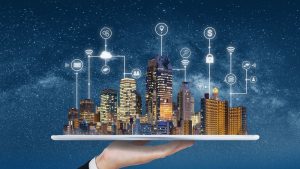The smart building market is projected to grow by 10.9%, from $72.6 billion in 2021 to $121.6 billion by 2026. Cloud-based technologies allow real estate companies to drive property value and attract more tenants.
Which are the best proptech security trends for real estate agents? Keep reading for an extensive guide to the proptech security trends that all real estate agents should know about — don’t miss out on crucial information that could help you to attract more tenants.
Integrating Cyber And Physical Security
When you adopt cloud-based technology for your physical security, you need to ensure that tenants feel their cloud-based security is protected from a cyber standpoint. For instance, if you implement cloud-based access control or video surveillance, you must ensure that no third party can access the data from these security tools.
If the remote operation of door locks fell into the hands of an unauthorized third party, this could cause a colossal security breach that puts the safety of your tenants in the balance.
To ensure that you secure all of your cloud-based physical security tools from a cyber standpoint, you need to integrate cybersecurity software with your cloud-based system. The cybersecurity software will ensure that your security tools’ remote operation or visibility features are only accessible to authorized parties.
Adopting Touchless And Hygiene-Based Technology
Touchless and hygiene-based technology is one of the most attractive features for tenants. Since the pandemic, businesses of all types have to explore technologies and tools that minimize the spread of germs in their establishments.
To attract and retain tenants, you can invest in touchless and hygiene-based technology that improves health and safety on the property. Listed below are the best touchless and hygiene-based technologies for your properties.
Touchless Access Control
To discourage the spread of germs on your property, you need to minimize the number of touchpoints that users must contact when moving throughout the building – such as door handles, handle rails, and elevator buttons.
One of the best technologies for reducing touchpoints is touchless access control. Touchless access control eliminates the need for keycards and fobs. Instead, users can download access credentials to their mobile device, enabling touchless entry.
When a user needs to enter the building, they can do so without pressing a button or swiping a card, which might encourage the spread of germs. All they need to do is wave their hand over the access control reader. When triggered, the reader is equipped with a motion sensor to initiate remote communication with the user’s device.
Wellness Verification Software
Wellness verification software is an integration for touchless access control that helps provide tenants with more assurance of their health and safety. It provides users with wellness surveys before entering the building, ensuring that symptomatic individuals cannot access the property.
When a user presents their access credentials to the reader, the software will provide them with a digital form to fill out based on their symptoms. If they are symptomatic, their access will be denied – the building staff can then handle the issue at their discretion.
Integrating Technologies
One of the key benefits of a cloud-based security system is open APIs. Open APIs allow you to integrate software and technologies into your security system to improve ROI on your security investments.
Here are some of the best integrations for a cloud-based security system:
- Visitor management software. You can make it easier for tenants to manage their visitors with visitor management software. The tool integrates with cloud-based access control, providing users with registration forms to fill out on their mobiles. Filling out this form will grant them temporary access credentials to enter the building — the system will automatically sign them in and out, revoking the credentials when they leave. Visitor management systems can also be integrated with access control turnstiles to track visitors as they enter and exit lobby areas in commercial real estate properties.
- Integrated access control and video surveillance. Integrating surveillance and access control allow you to host both access logs and video feed on a single interface, enabling identity verification. Hosting data sets separately will lead to more convoluted identity verification processes. This integration reduces the risk of stolen access credentials being used to enter the building.
Automating Building Management Triggers
One of the most popular smart solutions in real estate is automating building management triggers based on access control events. The energy cost is skyrocketing, and real estate companies must turn to smart technology to provide more energy efficiency.
Tenants pay unnecessary energy costs if a building is heated and lit when it is empty. Investing in IoT-connected building heating systems and HVAC systems can automate building management triggers based on access control events. When a person enters the property, these devices will turn on automatically – turning off when the last occupant leaves.
Additionally, you can identify occupancy trends from access control data to ensure your building is heated and cooled in line with occupancy figures.
Investing in more innovative building management technology can make a property more attractive to tenants by reducing their monthly overheads using energy-efficient solutions.
Summary
Smart technology is carving out a new path for real estate professionals – allowing them to drive up demand and value for their properties. You can drive value by making the tenant experience more hygienic, secure, and convenient with innovative technologies. Consider which technologies this article discussed would add the most value to your properties.







